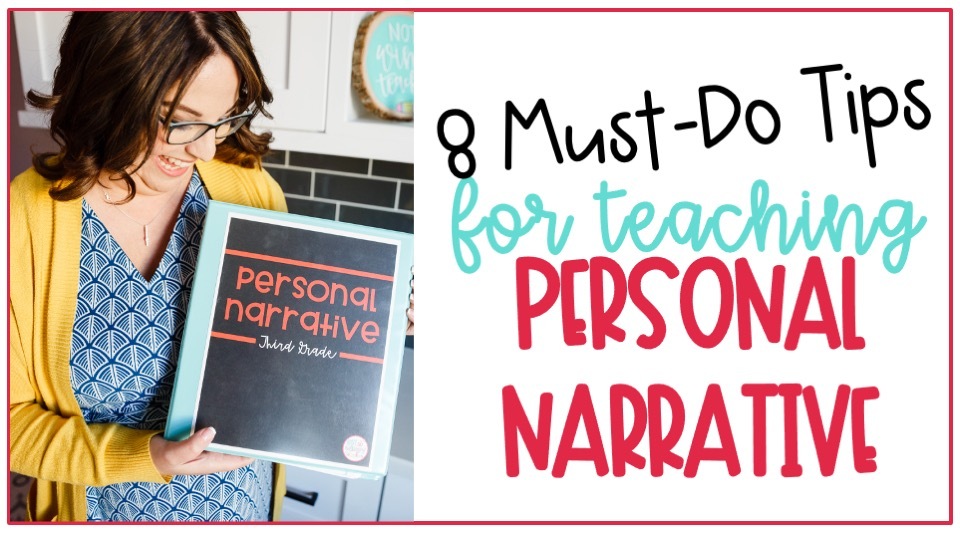
When I was in the classroom, I organized my writing instruction into units of study. Focusing on one unit at a time helps students become better writers. Rather than skipping around from topic to topic, students get to dig into one genre for eight weeks. This helps them truly master the skills and strategies of each genre. You can read more about teaching writing in units here.
My favorite genre to teach at the beginning of the year is personal narrative.
A personal narrative is a true story based on personal experiences. All students have personal experiences that they can write about it (although you may have to help them realize this), so this makes it an easy genre to use when you introduce writing. Students enjoy writing about themselves. They get excited to write narratives. Personal narratives also help you get to know the students at the beginning of the year.
Here are some tips for teaching personal narratives
1. Start with a pre-assessment
It’s important to start each writing unit with a pre-assessment. This allows you to see what students know before you teach the unit. A pre-assessment helps you plan lessons and form conference groups. It also gives you a baseline from which to measure student growth at the end of the unit.
Keep the pre-assessment assignment super simple. Give students a prompt so you can be sure they are using the right type of writing. And offer some suggestions for how to answer that prompt. For example: “Tell me about a time you visited a new place, such as a new school, a new friend’s house, a new playground, or a new city.” These suggestions help get students thinking about how to answer the prompt. Allow one writing period, between 30-45 minutes, to respond to it the best they can. Then use a simple rubric to score the sample, but don’t add the grade to the grade book.
Expect your students to struggle. Remember you haven’t taught this material yet. But make sure you let them work independently without commenting on their work.
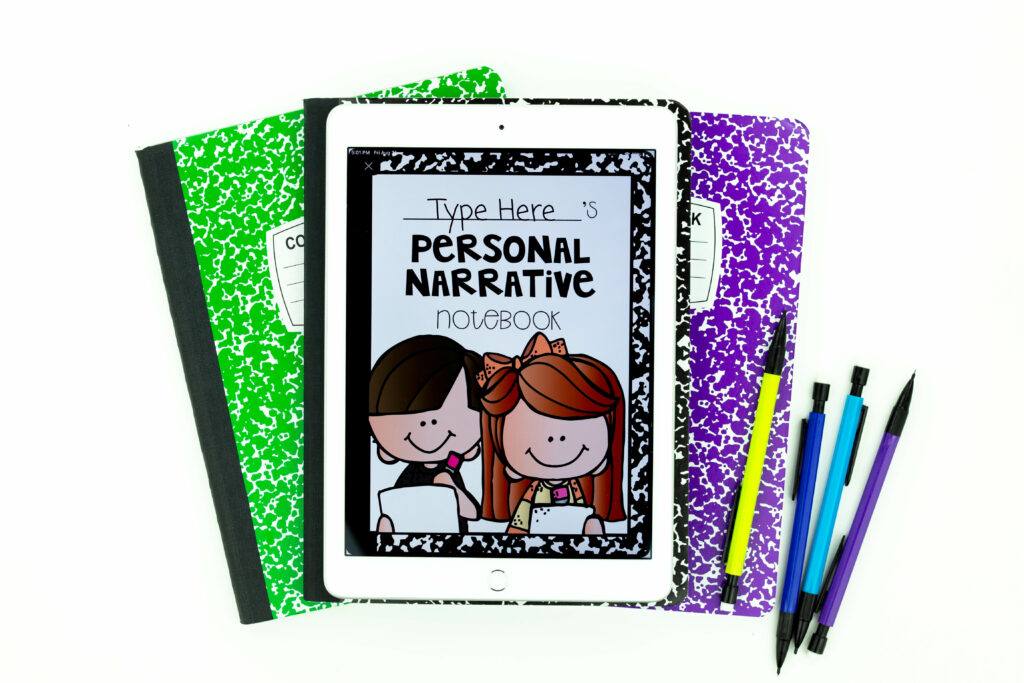
2. Make sure students know what a personal narrative is
If you want your students to be able to successfully write a personal narrative, you need to explicitly teach them what that is. Spend a day or two looking at examples of personal narratives. Use lots of mentor text passages and books. My writing units include the relevant mentor texts, but your classroom or school library also has many examples.
After you’ve provided several examples, give students a chance to apply what they learned. A task card scoot is a great way to check for understanding.
3. Teach students how to generate a personal narrative topic
When students are permitted to choose their own topic, they are more excited about writing. Selecting a topic that is interesting to them gives them ownership over their writing and makes it more meaningful. So rather than directing all your students to write about “A Time I Felt Proud,” allow them to select their own topic.
But, and this is so important, you need to teach them how to do this. Otherwise, you’ll be faced with a lot of blank pages and “I don’t know what to write about” complaints. Plan to spend a couple of days demonstrating strategies for generating topics. My writing units include these lessons.
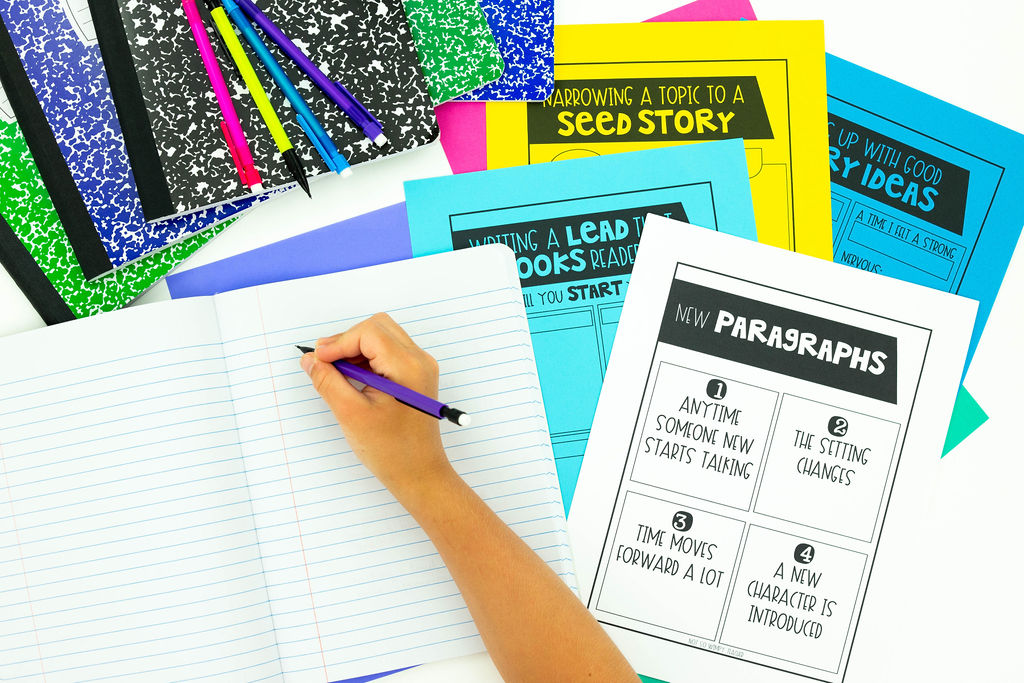
4. Let them write right away
One of the biggest mistakes teachers make when teaching writing is waiting too long to let kids start drafting. If you try to teach every skill related to personal narrative before letting students write, they will get bored.
Let them start drafting early. As soon as you’ve taught students how to generate a topic, let them get their ideas on paper. The first draft won’t be perfect, but it’s not supposed to be. They are just getting started.
5. Don’t get discouraged
Their first drafts are not going to be very good. This is true of all first drafts. But especially at the beginning of the year. Students might be a little rusty after summer vacation. Or they may have never learned how to write before.
Don’t get discouraged. You haven’t even started teaching writing yet. Over the next several weeks, you will teach them lots of strategies to improve their writing. And they will have many opportunities to revise that first draft. Between mini lessons, writing conferences, and independent practice their writing will get better.
6. Teach one skill at a time
After students have completed their first draft it’s time to get into the nitty-gritty lessons of what makes a good personal narrative. Plan to focus on just one skill at a time. And take your time teaching that skill.
Some important skills to teach during personal narrative are strong leads, dialogue, paragraphs, and show don’t tell. But you can’t teach any of these topics in one day.
Instead of introducing the topic of interesting leads and giving students three or four examples at once, you might teach the skill over three days. Each day you can introduce just one interesting type of lead and have students go back to their draft and revise it to reflect what they just learned. This means they’ll write three interesting leads for one story. At the end of the topic, they can choose the one they like best. But they will have had practice experimenting with all three and will have three new tools in their writing toolbox.
Curious about what other skills you should teach in the personal narrative unit? Check out my FREE What to Teach in Writing Guide for a complete list.
7. Break down the editing process
It’s important that you teach kids how to edit. If you just tell them to edit their work, chances are they will spend two minutes skimming it and tell you it’s good. And you will see ten errors in two seconds.
Rather than just giving them the task of editing, break down the process and have them focus on one specific item. Maybe you want your students to make sure all their sentences start with a capital letter or end with a punctuation mark. Or maybe you want them to focus on indenting their paragraphs.
You can choose any skill you want to emphasize, but don’t expect them to edit everything all at once. And once they are finished editing, resist the urge to point out all the other mistakes. Remember, the purpose of writing is communicating ideas, not perfecting spelling or grammar.
8. Celebrate student writing
This is the best part! Once students have finished their masterpieces, find a fun way to publish them. You can create class books or blogs. Or let students write their final copy on fancy paper.
Make sure to allow time for students to share with one another. Authors write so that they can share their stories with others. And kids really enjoy the opportunity to share their writing.
Try an author celebration. There are many ways to do this in the classroom. You might turn your classroom into Camp Share-a-Story. Bring in sleeping bags, flashlights, and simple s’mores and allow students to share their stories in small groups while a campfire plays on YouTube on the whiteboard.
Or invite parents to visit for a “book launch.” Let the students read their stories to their adult visitors while sipping punch. The key is to make it fun so that students look forward to their next writing piece.
Personal Narrative Writing Units
If you’d like even more help teaching personal narrative, my writing units may be just what you are looking for.
These units are available for grades 2-5 and come with EVERYTHING you need to teach personal narrative writing for 8 weeks. I’ve even included all the mentor texts you need. You don’t have to purchase any additional books or spend hours hunting in the library!
The lesson plans are simple. All you have to do is print and teach.
Students will learn all the skills necessary for a small moment story with dialogue, a strong lead, interesting word choice, paragraphs, and so much more. There are digital anchor charts you can just project onto your whiteboard to save time.
Finally, these units make writing fun for your students. You may even find that your students moan and groan when writing time is over. And when students enjoy writing and get lots of practice, they perform better on standardized tests.
Shop This Post
Or, save money and buy a bundle of all 4 writing units: personal narrative, informational essay, opinion, and fiction narrative. You’ll have everything you need to teach writing for the entire year!
Work With Me
I created the Not So Wimpy Writing Masterclass, an online professional development course specifically for teachers in grades 2-5. The tips and strategies inside the course will help you ditch the overwhelm and become a more confident writing teacher who inspires students and transforms them into kids who love to write.
When you enroll in the Masterclass, you’ll learn tried and true strategies for how to teach writing, including how to:
- Teach writing in units
- Create manageable mini-lessons
- Keep students on task during independent writing time
- Implement a successful writing workshop without chaos and confusion
- Transform ALL your students into eager and excited writers who have the skills needed to perform well on standardized tests
This course will make teaching writing easier, more effective, and a heck of a lot more fun! And this professional development is easy! The course is completely online and self-paced. So you are in complete control of your schedule.
Registration for the Not So Wimpy Writing Masterclass is currently closed. Be sure to sign up for the Waitlist so you will be the first to know when we open it again. Sign up now so you don’t miss out!
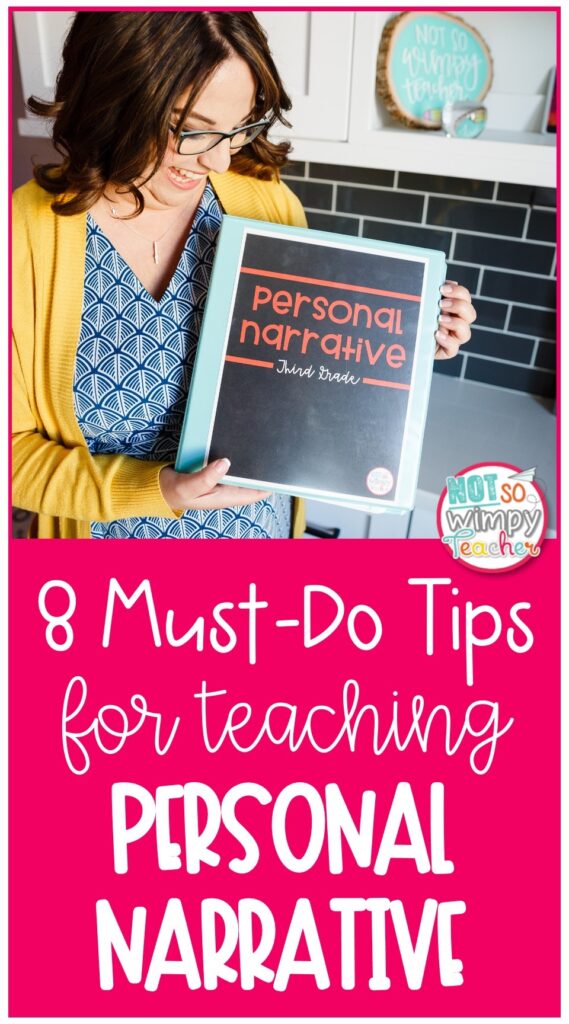
Have a Not So Wimpy day,


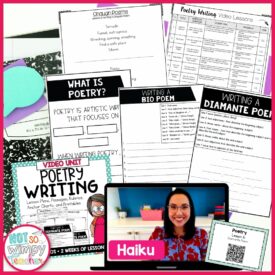
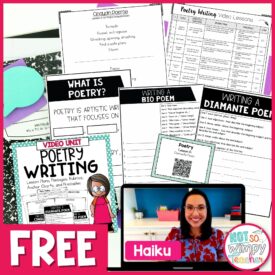

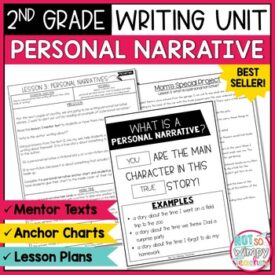
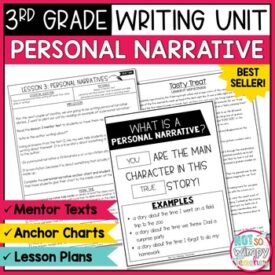
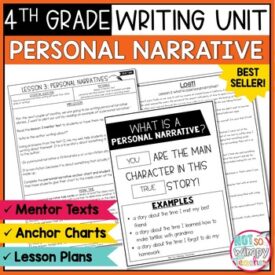
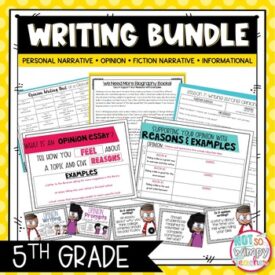

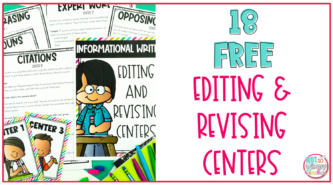
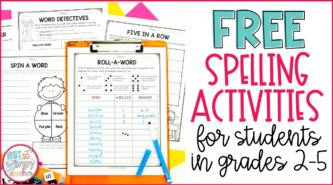












 End of Year Carnival Week for grades 2-5!
End of Year Carnival Week for grades 2-5!
Leave a Comment